Day 2 of a three day long weekend of Late Winter Birding tours today, and we spent the day in North Norfolk. It was forecast to be dull and cloudy all day, but thankfully we were treated to some long spells of sunshine, great winter weather to be out birding. There was still a bit of a chill in the brisk SW wind though – it is February after all!
As we made our way down towards the coast, a Red Kite circled lazily through the trees beside the road. We flushed a Common Buzzard out of the trees too, as we stopped, which flew away across the fields. A dead Brown Hare lay on the tarmac, which was obviously being eyed up by the local raptors. We watched as the Red Kite turned over the trees, twisting its tail like a rudder, before it too reluctantly drifted away, leaving behind its potential meal.
Our first destination was Holkham. There were lots of ducks on the pools alongside Lady Anne’s Drive – Wigeon, Shoveler and Teal. However, there were no Pink-footed Geese here today. Numbers of geese are now falling as the birds have started to make their way back north again after the winter.
Parking at the north end of the road, we made our way out through the pines and onto the saltmarsh. There were several birders making their way back along the sandy path who told us that our quarry was ahead. Shorelarks. The birds had been harried and chased around by a photographer, who was just leaving as we arrived, and they were rather skittish and unsettled initially.
They had been mostly keeping to the longer vegetation but when the Shorelarks were flushed by a loose dog and its associated walker, they flew round calling and landed on a more open area. We got them in the scope from a distance at first, and admired their canary yellow faces with black bandit masks, bright in the morning sunshine.
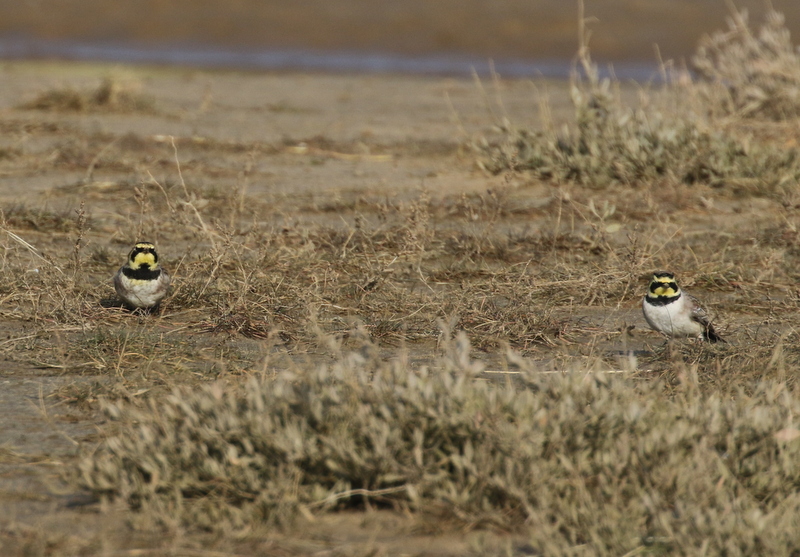 Shorelarks – their bright yellow faces catching the morning sun
Shorelarks – their bright yellow faces catching the morning sun
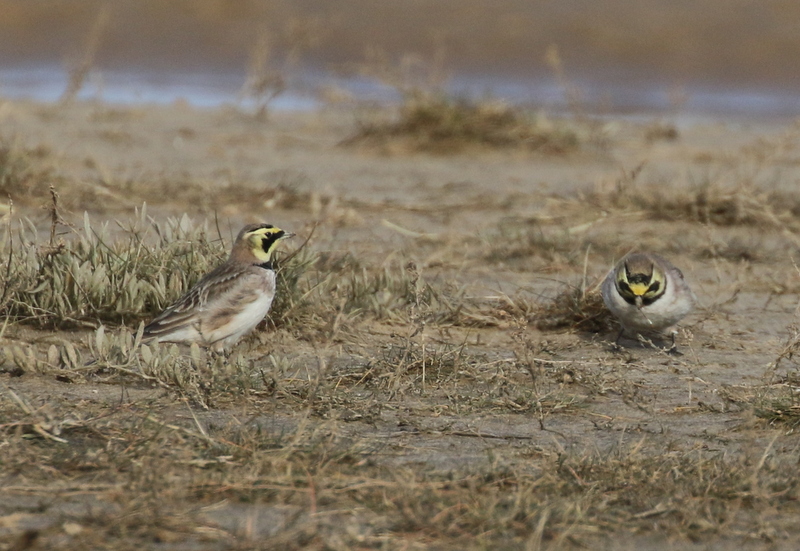 Shorelarks – around 30 were still at Holkham this morning
Shorelarks – around 30 were still at Holkham this morning
The Shorelarks flew round again and settled near the path. We positioned ourselves nearby and waited patiently, rather than chasing in after them. Gradually, a small group, four of them, came out of the taller sea purslane towards us and started picking at the seedheads of the saltmarsh vegetation in front of us. We enjoyed some great close up views through the scope of them feeding. The poor Skylark singing its heart out in the sky high overhead was all but ignored until we realised that we could listen to one and watch the other, and enjoy both.
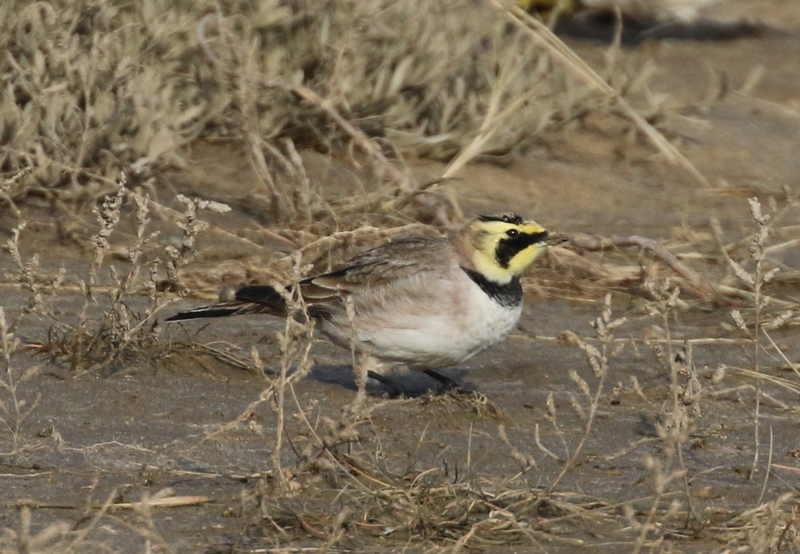 Shorelark – came to us as we waited patiently
Shorelark – came to us as we waited patiently
The Shorelarks are winter visitors to the coast here, in very variable numbers. In recent years, only a very small number have typically made it here, but this winter has seen a resurgence. Early on in the winter, 70-80 were here at Holkham but they have now dispersed along the coast a little. Still, it was a real treat to see a flock of 30 here today.
After watching the Shorelarks for a while, we made our way over to the dunes and had a look out to sea. A drake Red-breasted Merganser we got in the scope was asleep but a drake Goldeneye was awake, its glossy green head catching the sunlight. Several Great Crested Grebes were mostly rather distant, but a winter plumage Red-throated Diver was diving just off the beach. Between dives, everyone eventually got a really good look at it through the scope.
After a great start to the morning, we made our way back to Lady Anne’s Drive. The lure of a hot drink at the coffee van proved too strong and we drank it by the picnic tables looking out over the marshes. There was a lot of action here. As well as all the Wigeon and Woodpigeons, a pair of Mistle Thrushes were feeding out on the grass, amongst the molehills. The sunshine had brought the raptors out and at least four Common Buzzards circled over us.We had failed to find any Pink-footed Geese on the grass by the drive earlier, but a flock of about 50 flew in from the west and landed on the marshes, though unfortunately behind a hedge where we couldn’t get a clear look at them.
 Common Buzzard – several circled over Lady Anne’s Drive in the sunshine
Common Buzzard – several circled over Lady Anne’s Drive in the sunshine
Three large white shapes circled up out of the trees in the middle of the marshes. With their long necks held outstretched in front and long legs trailing behind, we could see they were Spoonbills. They dropped down into the trees, but a few minutes later were up and circling again. They repeated this a couple of times more. The UK’s only colony of Spoonbill breed here so these were early returning birds presumably checking out the colony. Spring is definitely in the air!
We made our way round to the other end of the freshmarsh, closer to the trees, and it wasn’t long before the Spoonbills were up and circling again. We had a much improved view of them from here. Even better, when they landed back in the trees at one point, one was in view so we managed to get it distantly in the scope. We could see the yellow tip to its black spoon-shaped bill, confirming that it was an adult Spoonbill.
 Spoonbills – early returning birds checking out the colony
Spoonbills – early returning birds checking out the colony
Another large white bird out in the middle of the freshmarsh was a Great White Egret. Even without binoculars, we could see it was huge, with a long neck. Through the scope we could see its long, dagger-shaped yellow bill. There were also three Ruff feeding out on the grass around one of the pools. Several Marsh Harriers and Common Buzzards circled in the sunshine or perched around in the trees.
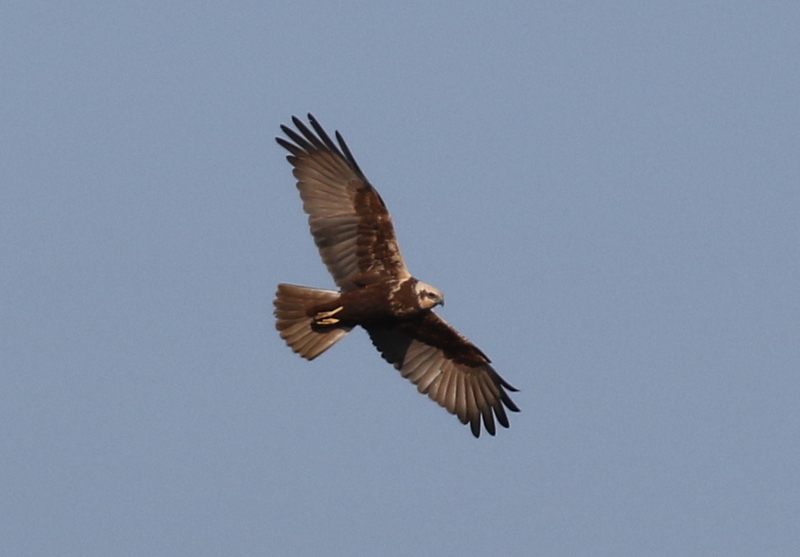 Marsh Harrier – a female, circling above the marshes
Marsh Harrier – a female, circling above the marshes
The other highlight here was the geese. Scattered across the grass, mixed in with the Greylags, we could see lots of White-fronted Geese. Smaller and darker than the Greylags, through the scope we could see their more delicate pink bills with distinctive white surrounds to the bases. We could also see the distinctive black belly bars on the adult White-fronted Geese. They should be on their way back north soon, back to northern Russia where they breed.
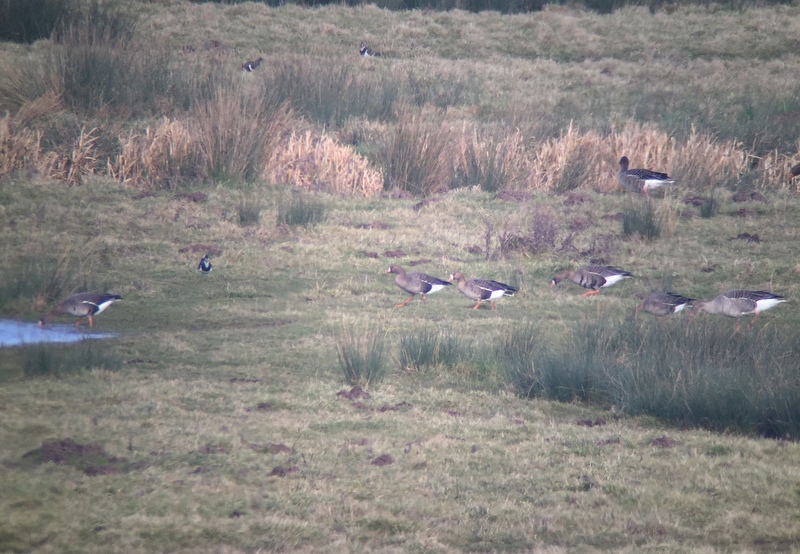 White-fronted Geese – there were still a good number at Holkham today
White-fronted Geese – there were still a good number at Holkham today
From here, we also finally managed to find some Pink-footed Geese on the ground and in view. There were just two of them, but they were handily with a couple of Greylags for comparison. Again, the Pink-footed Geese were smaller and darker, particularly dark on the head and neck, with a more delicate dark bill. Through the scope we could see the pink legs and pink bank around the bill. There were also a couple of Egyptian Geese out on the grass, just to round off the goose selection nicely.
Leaving Holkham, we made our way west. Our next stop was at Brancaster Staithe, where the tide was on its way out. There was a nice selection of waders feeding around the harbour. We had a good look at some Bar-tailed Godwits, noting the dark streaks on their pale buff-coloured upperparts an the long but slightly uptilted bill.
 Bar-tailed Godwit – showed well at Brancaster Staithe
Bar-tailed Godwit – showed well at Brancaster Staithe
Lots of Turnstones and several Oystercatchers were picking around the piles of discarded mussels on the shoreline. A couple of Grey Plovers were picking around on the mud, and a group of smaller Dunlin were feeding feverishly in the shallow water.
It was lunchtime when we arrived at Titchwell, so we made our way to the picnic area. We had been intending to sit at the picnic tables, but we didn’t get a chance! First of all, we heard a Goldcrest singing and walked over to see it flitting around in the bare sallows right by the path. There were lots of Goldfinches twittering high in the alders and then a pair of Siskin appeared with them. The male fed in the top of one of the trees in the sunshine for a minute or so, where we could get a good look at it.
Then one of the group spotted another bird in the top of the same alder. It was hanging on one of the outer branches, picking at the cones. It was much paler and browner, and when it turned to face us we could see that it had a small red patch on its forehead and a bright pinkish red wash across its breast. A Mealy Redpoll and a smart male too. When it climbed around reaching for the cones, we could see it had a distinctive pale whitish rump streaked with black.
 Mealy Redpoll – feeding in one of the alders opposite the picnic area
Mealy Redpoll – feeding in one of the alders opposite the picnic area
After lunch, we headed out onto the reserve. We had a quick look at the feeders the other side of the visitor centre, but at first there were no birds. Gradually, they started to reappear – Chaffinches, Greenfinches, Goldfinches and tits. Finally a Brambling flew in and joined them. It was a female, with greyish head and a pale orange wash across the breast and shoulders contrasting with the white belly.
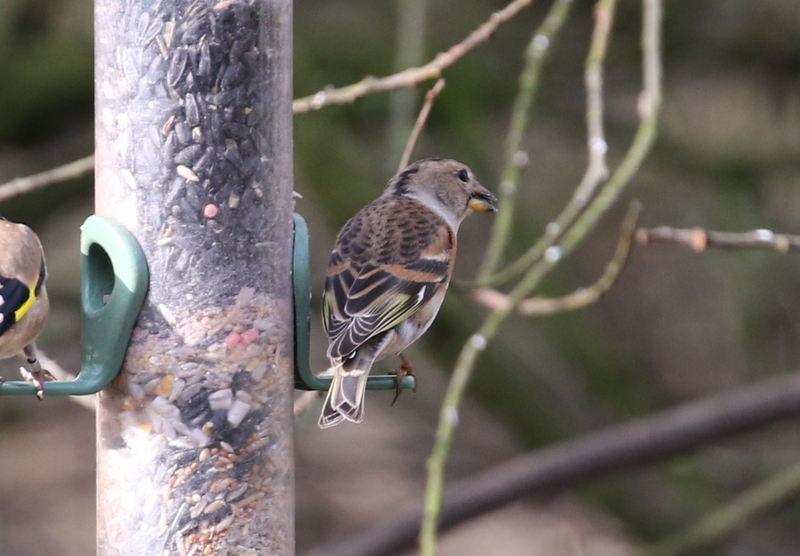 Brambling – a female on the feeders by the visitor centre
Brambling – a female on the feeders by the visitor centre
On the walk out along the main path, we had a quick look in the ditches either side but could not see a Water Rail – we resolved to have another look on the way back. The grazing meadow dry ‘pool’ was rather quiet again, but the reedbed pool the other side held a small group of Common Pochard, along with the regular Mallards and Coot. We stopped to have a look around the reeds. There had been a Bittern feeding in one of the channels yesterday, but there was no sign of it this afternoon. However, we did find a Kingfisher perched in the edge of the reeds.
The water level on the freshmarsh is still rather high, although a few small islands have started to reappear. This is continuing to prove popular with the wildfowl, and there were good numbers of Teal on here still today, as well as a selection of Shoveler, Gadwall and Wigeon. A large flock of Brent Geese flew in from over towards Brancaster and dropped in for a wash and a drink.
The number of Avocets is now starting to increase again. They were mostly sleeping by one of the smaller islands, until everything was spooked and they flew round flashing black and white as they twisted and turned. A small group of Knot and Dunlin were bathing on one of the other small islands. The larger fenced-off island was absolutely packed with Golden Plover and Lapwing.
 Avocets – numbers are increasing again as birds return after the winter
Avocets – numbers are increasing again as birds return after the winter
The mud on the Volunteer Marsh is proving a more attractive feeding ground for waders and there was a nice selection on here again today. A lone Ringed Plover looked very smart in the scope, with the black and white rings around its head and neck. A Grey Plover was looking very pale in the sunshine. There were lots more Knot and Dunlin on here, plus a few Curlew and Black-tailed Godwit.
As we made our way over to the bank at the far side of the Volunteer Marsh, one of the group spotted a Water Rail scuttling into the vegetation right below the bank. We waited and eventually it showed itself again briefly. We thought it might work its way all the way along beneath us, but when it came to a more open area it stood lurking in the vegetation for a couple of minutes before thinking better of it and heading back in the better hidden direction from whence it came.
 Water Rail – lurking in the bushes on the edge of the Volunteer Marsh
Water Rail – lurking in the bushes on the edge of the Volunteer Marsh
Out at the Tidal Pools, there were a couple of nice close Black-tailed Godwits. Conveniently, a Bar-tailed Godwit was also nearby, giving us a chance to compare the two. We could see the buffier upperparts of the latter, extensively streaked with black, compared to the plainer, duller grey Black-tailed Godwit. The Bar-tailed Godwit was also noticeably smaller and shorter legged, with a distinct upturn to its bill compared to the straighter billed Black-tailed Godwit.
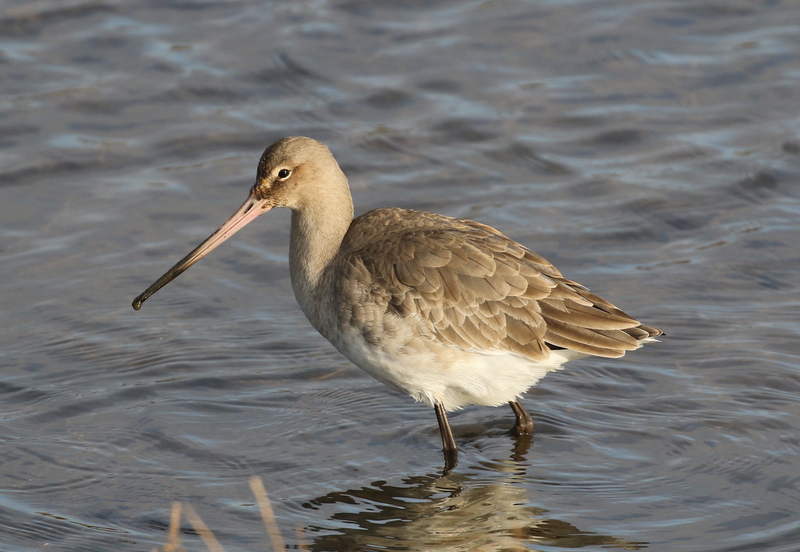 Black-tailed Godwit – showing very well on the Tidal Pools
Black-tailed Godwit – showing very well on the Tidal Pools
Next stop was the beach. As soon as we came through the dunes, we could see a huge raft of scoter out on the sea, several thousands strong. It looked like a massive black oil slick across the water. Periodically, parts of the raft would take off and fly a short distance and in flight we could see that the vast majority of these birds had all black wings, making them Common Scoter.
Closer in, we could see some smaller rafts of scoter and through the scope we could see they were made up of a nice mixture of Common Scoter and Velvet Scoter, including at least 30 of the latter. Several of the Velvet Scoter were conveniently holding their wings loosely folded, which meant that we could see the white wing patch as a white stripe across their sides. Others had more distinctive twin white spots on their faces, very different from the pale cheeks of the female Common Scoter.
Two Long-tailed Duck flew across and landed on the sea next to one of the closer scoter rafts. We managed to get them in the scope, but they were hard to see against the water, which was also a bit choppier now than it had been this morning. While we were trying to get everyone to get a look at them, they flew again and disappeared.
It is very mild at the moment for February, but out of the sun in the lee of the dunes, and with the chill in the wind, several of the group were getting cold. With the sun already starting to sink in the sky, we decided to call it a day and make our way back.
There were still some more things to see. Scanning along the channel on the north edge of the Volunteer Marsh, a much paler wader caught our eye. It was a Spotted Redshank in silvery grey and white winter plumage. It walked across the mud and dropped down into the deep channel in the middle. Thankfully we picked it up again walking towards us in the channel and then it climbed out again onto the mud.
As we walked past the freshmarsh, all the waders took flight. They seemed to be especially jumpy this afternoon. We stood and watched the Golden Plover and Lapwing wheeling in the sky over the water, and then a large group of Golden Plover flew towards us and right overhead – we could hear the beating of their wings.
We had failed to find the Water Rail in the ditch by the path on the way out, but on our way back it was feeding down in the bottom, under an overhanging tree. We got a good look at it through the branches, probing around in the rotting leaves. A nice way to end the day, then it was back to the car and time to head for home.
















